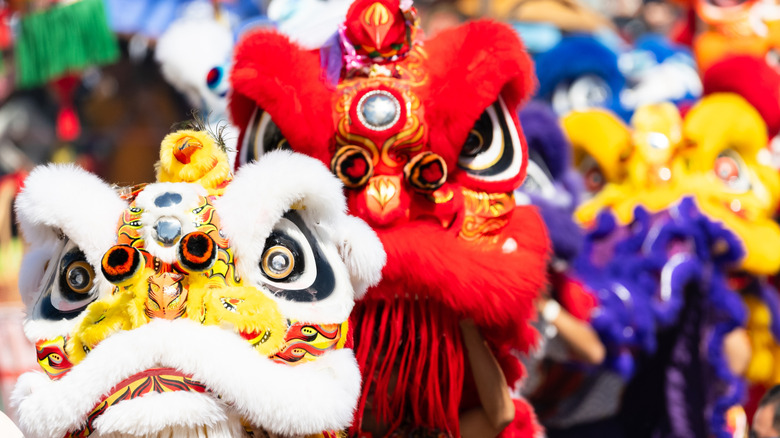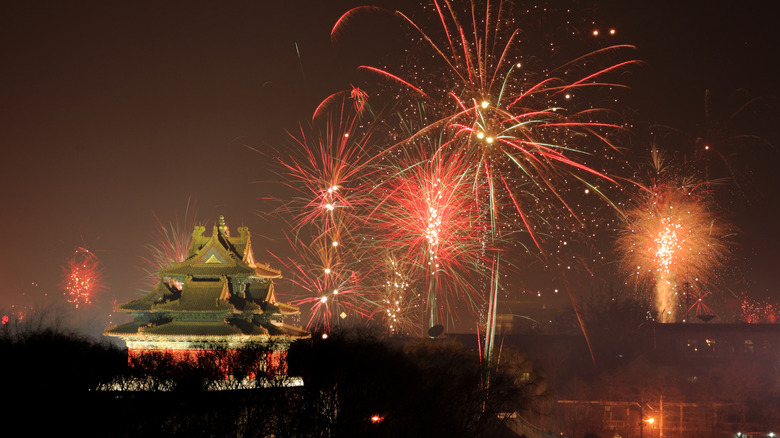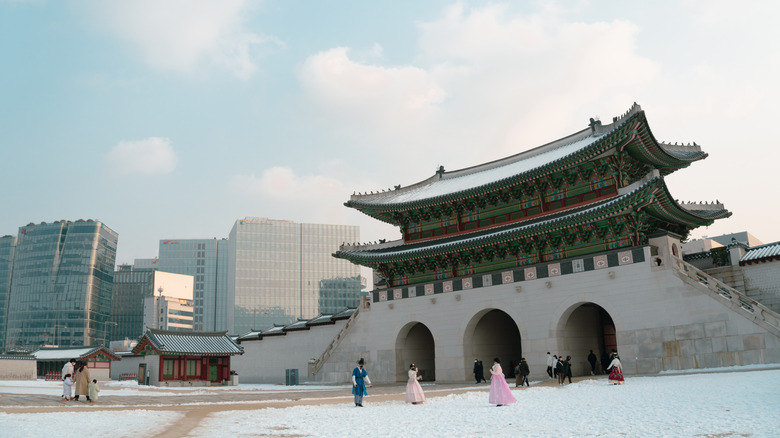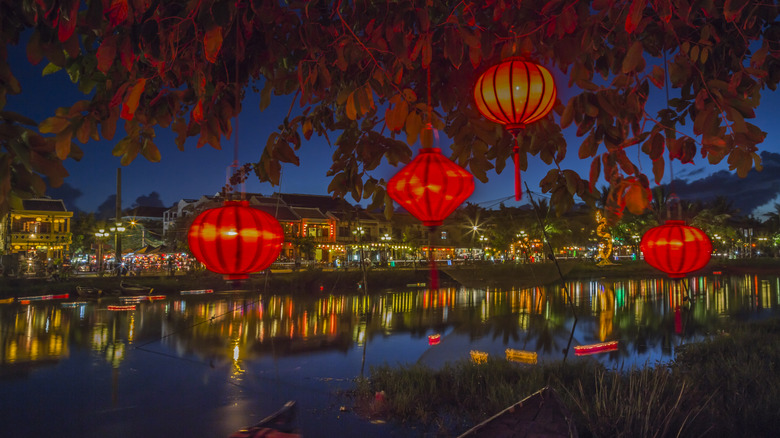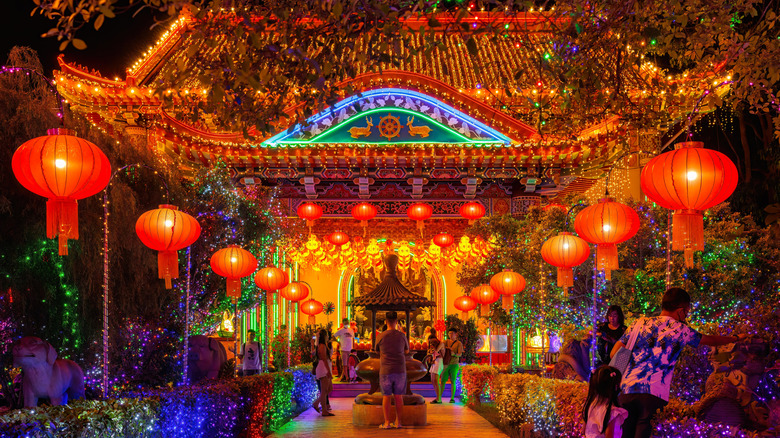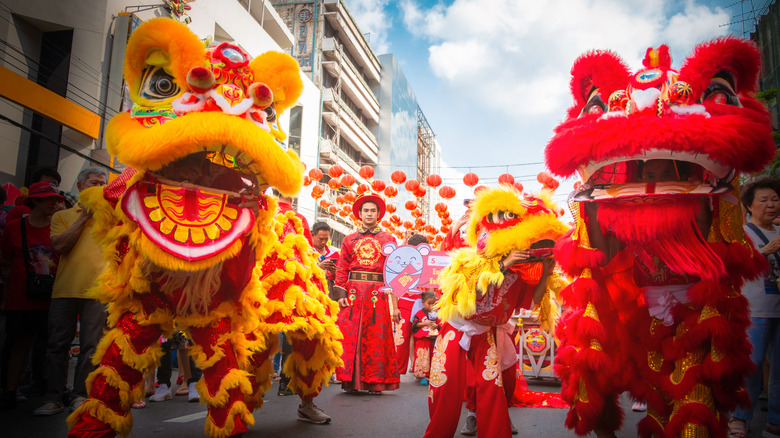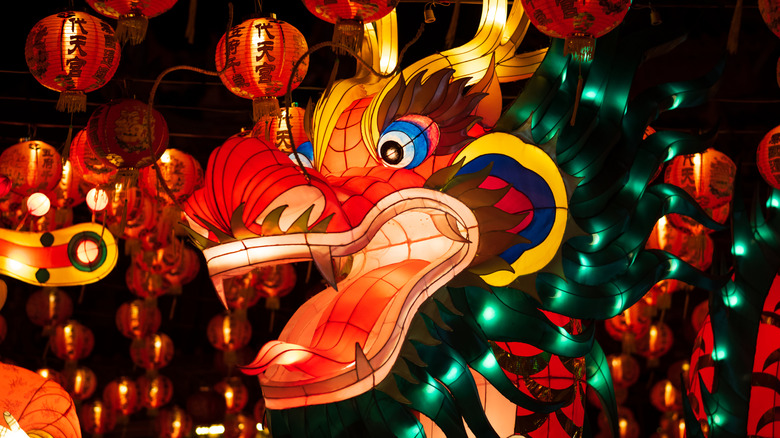The Best Countries In Asia To Experience Lunar New Year Celebrations
The Lunar New Year, also known as the Chinese New Year or the Spring Festival, is a special time when the Chinese, its communities worldwide, and others who observe the lunar calendar celebrate the first new moon. Typically lasting for 15 days between January 21 and February 20 in the Western calendar, people across Asia rejoice during the most significant holiday of the year. In many parts of Asia, people travel far and wide to have festive, multi-day family dinners while performing traditional rites to ensure a prosperous coming year. Think of it as a mega-holiday where Thanksgiving, Christmas, and New Year are rolled into one.
How did the Lunar New Year start? According to Chinese legend, a ferocious monster, Nian, attacked villages at the start of each year, destroying livestock and killing villagers. One day, a stranger arrived in town, promising to get rid of Nian permanently. He waited for the beast to appear while he cleaned the house of one of the villagers, lit it with candles, and decorated it in vibrant red. As Nian approached the house, a loud crackling noise from firecrackers startled the monster. Then, the man jumped out of the house dressed in new red clothes and roared in laughter, sending the beast running. When the villagers returned to find their homes intact, they cheered. Thus began the Lunar New Year traditions: cleaning and decorating the house in festive red, purchasing new clothes, and lighting fireworks.
From China to Korea and in Vietnam, Malaysia, and Thailand, don't miss out on the grandest New Year celebrations across the continent. To select the best, we consulted governmental websites and travel bloggers who attest to Asia's most unique and representative Lunar New Year celebrations.
Visit China for the quintessential Lunar New Year vibe
Some argue the Lunar New Year is the worst time to visit China. However, with some careful planning, you can have the best time participating in the grandest traditional celebrations. To fit in with the locals, practice saying "xīn nián kuà ilè" (Happy New Year) in Mandarin. Also, don't forget to apply for your Chinese tourist visa before planning your festive vacation.
In Beijing, go to one of the city's largest and most popular celebrations at the Ditan Park Temple Fair. There are hundreds of stalls where you can sample local snacks and shop for antiques. This is also where Qing Dynasty ceremonies, traditional dances, and jaw-dropping acrobatic performances take place. Alternatively, Dongyue Temple, an ancient religious site dating back to the Yuan dynasty, also has a fair. This fair specifically promotes the auspicious concept of fu (good fortune in Chinese). You can pray for an abundance of fu in the coming year and pick up one of the fu-themed souvenirs featuring your zodiac animal.
You can also soak up the new year's energy in the cosmopolitan city of Shanghai. The New Year's Eve Flower Show at Shanghai Botanical Garden is not to be missed. We can't think of a better way to say goodbye to the old year than to be surrounded by blooming orchids and petunias. The annual Yuyuan Garden Lantern Festival is always impressive with its immersive installations and a collection of zodiac animal lanterns. For fantastic fireworks and other festivities, head to the Fangtayuan New Year Amusement Park. Finally, the Shanghai New Year Customs Exhibition at the Shanghai Mass Art Center is where you can see amazing Spring Festival couplets and calligraphy made by renowned artists and enjoy a traditional shadow puppet show.
Head to Korea for a quiet but unique celebration
Known locally as Seollal, many people in Korea return to their hometowns for the new year. Therefore, the Lunar New Year celebrations in Seoul — Korea's capital famous for its trendy Hongdae district, thriving music scene, and lively nightlife — seem muted compared to some, but they're unique nonetheless. Bonus: This means the usual sightseeing hotspots are less crowded than usual.
Four of Seoul's royal palaces — Gyeongbokgung, Changdeokgung, Changgyeonggung, and Deoksugungand — offer special events and performances during Seollal, and they often give away a limited number of New Year-themed souvenirs. Since most locals have gone home for the holidays, the palaces are less crowded, so you can get fantastic photos of the grand Gyeongbokgung Palace in its glory. Another bonus is that all the historical sites have free admission during Seollal.
Namsangol Hanok Village in the center of Seoul is another great spot to visit during the holidays. The village consists of five restored hanok (traditional Korean homes), pavilions, a traditional garden, and a plaza that will transport you back in time. During the Seollal holidays, the village is decked out with various festivities, and you can see how Koreans in the past rang in the new year. Queue early for special hands-on activities, such as making a hanji hand mirror, a wonderful gift to bring home. When you meet a local person during Seollal, greet them with "saé haé bok man-i bad e sé yo" (Happy New Year), to bring a smile to their face.
Joyous celebrations across Vietnam
Tết Nguyên Đán is the Lunar New Year celebration in Vietnam that celebrates its unique culture. Hoi An, the mini Venice of Asia, might be the most romantic place to spend Lunar New Year. The streets of Hoi An and surrounding historical buildings are spruced up to welcome the new year, and markets start to pop up as Tết approaches. On Lunar New Year's Eve, a parade kicks off in the Ancient Town, followed by an art show and the grand fireworks over the Hoai River. The Bai Choi singing contest, considered an Intangible Cultural Heritage by UNESCO, is a fun event where people sing traditional folk songs and play an ancient game significant to Vietnamese culture.
Vietnam's capital, Hanoi, also has celebrations around the famed Hoàn Kiếm Lake. It is decorated with flowers and lights, and the magical atmosphere is the perfect spot for a New Year stroll. However, the most impressive firework displays will ignite in six locations across the southern city of Ho Chi Minh City, where the biggest parties take over the streets. One of the most charming festivities in HCMC is the book festival, which takes place from the first to the fourth day of the new year in District 1 (a delightful signal that Vietnamese people are still exchanging and buying books to welcome the New Year in our digitally saturated world). Don't forget to hit the city's Chinatown, where generations of Chinese Vietnamese folks have kept their traditions alive and adopted the cultural practices of their homeland. Before your trip, practice the most common way to say "Happy New Year" in Vietnamese: "Năm mới vui vẻ."
The charming tropical celebrations in Malaysia
Penang has a large Hokkien-speaking Chinese diaspora population, making it one of the most distinct places to celebrate the Lunar New Year. Pineapples take center stage in Penang's celebrations, as ong lai, the Hokkien word for pineapple, is a homonym for "arrival of prosperity." Roam the streets of Georgetown to bask in the carnival-like festivities of street vendors, lively performances, and fireworks. For an unforgettable experience, head to Hai Choo Soo Temple in Tanjung Tokong for the Chneah Hoay (flame-watching) ceremony to welcome the new year. It's a 200-year-old tradition in which the locals gather to pray to the Tua Pek Kong, the god of prosperity. Right after midnight, the temple plunges into celebration, and the first blazing flame symbolizes an auspicious and successful year ahead.
Similarly, Malaysia's capital, Kuala Lumpur, has lively merriment, especially in and around Chinatown at Petaling Street. Surrounded by red lanterns, you can get a snack or pick up a souvenir from the street hawkers. Chinese temples are also centers of many joyous celebrations, including the Thean Hou Temple and Guan Di Temple, where you can enjoy jubilant vibes and live performances. There are many epic Lunar New Year decorations around the city, like those at the glittery Pavilion Kuala Lumpur, in the heart of the city, and at Merdeka Square. Both places have impressive Lunar New Year installations that provide the perfect backdrops for your Instagram Reels. A handy Malay phrase during the new year is "Selamat Tahun Baru Cina" (Happy Chinese New Year).
Watch the lion dance to ring in the new year in Thailand
Though not technically a national holiday in Thailand, the country's large Chinese community still throws good parties around the Land of Smiles every Lunar New Year. To greet a local during this special time, you can say "Sin jia yoo ee sin nee huad chai," a phrase to wish them a prosperous year ahead.
In Bangkok, go to Chinatown on Yaowarat Road, where the entire road is blocked off for the epic lion dance and other festivities, and the street is flooded with happy well-wishers dressed in red. Then, visit the Wat Mangkon Kamalawat temple on Charoen Krung Street or the Chow Sue Kong Shrine in Talad Noi, a relatively calm spot. The temples are a respite from the hustle and bustle of the crowds, where you can savor a quieter moment of reflection.
Similarly, Chiang Mai, the northern Thai city known for its explosive Flower Festival, also decks out in red and gold for the Lunar New Year. A parade on the first day of the new year starts from Thaphae Gate, and you can follow the procession to Warorot Market, east of the old city. It's typically a 10-minute walk away, but be prepared to take much longer on the first day of the Lunar New Year as everyone will be vying to get to the stage facing the Ping River, the epicenter of the activities. There will be a rotation of performances throughout the day, followed by a fashion display at night. While you're there, sample some pad woon sen, a glass noodle stir fry dish. Many vendors will sell the Hainanese version, the perfect fusion of Chinese and Thai cuisine.
How we selected the destinations
While some Lunar New Year traditions are consistent across Asian cultures, each country has its own unique interpretation of celebrations. Our goal was to feature five unique destinations with a strong local influence, including some non-Chinese-speaking countries to reflect the diversity of cultural practices. While we are unable to visit each location personally, we relied on government websites, bloggers, and local tourism companies to pinpoint the most festive and distinctive locations that are not only fun to visit during the Lunar New Year but also worthy of a visit beyond the holiday season.
